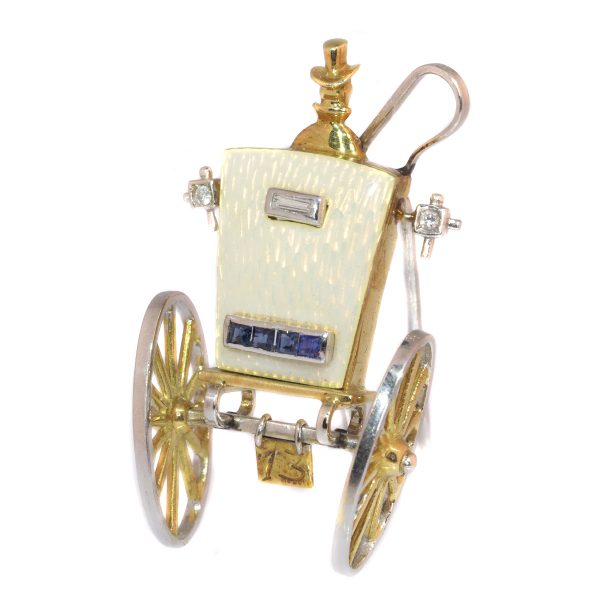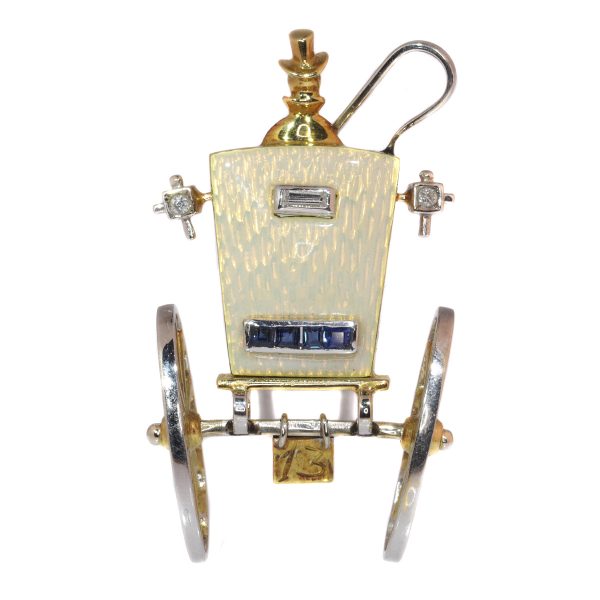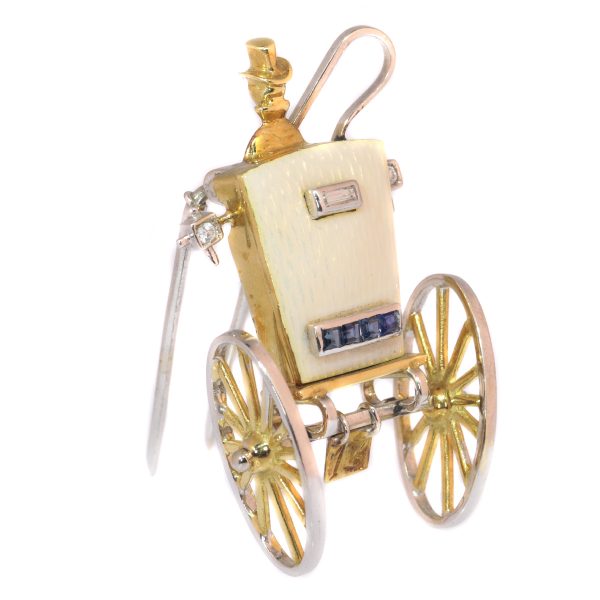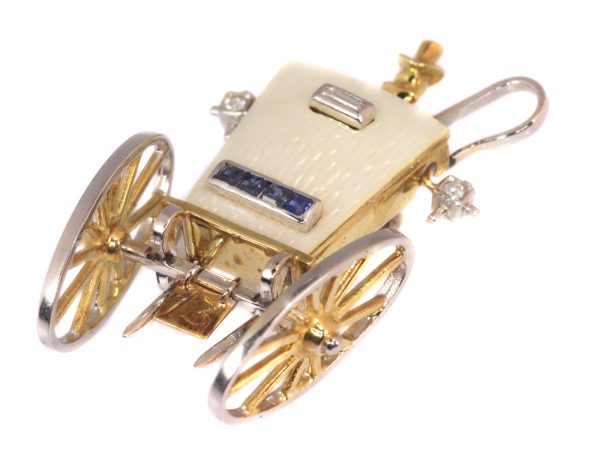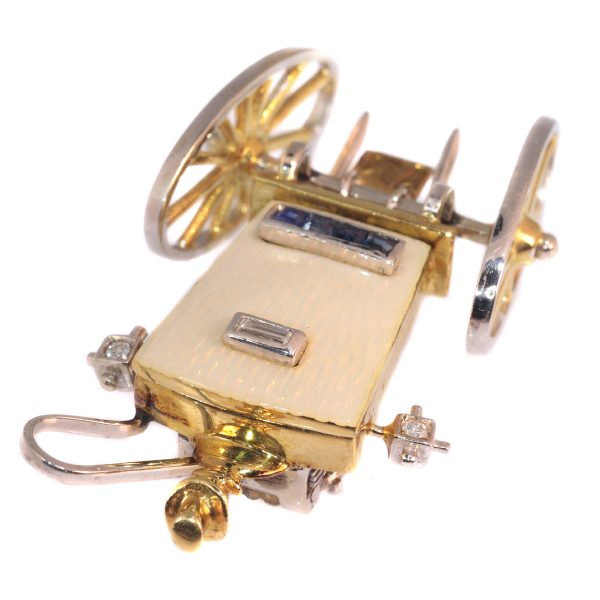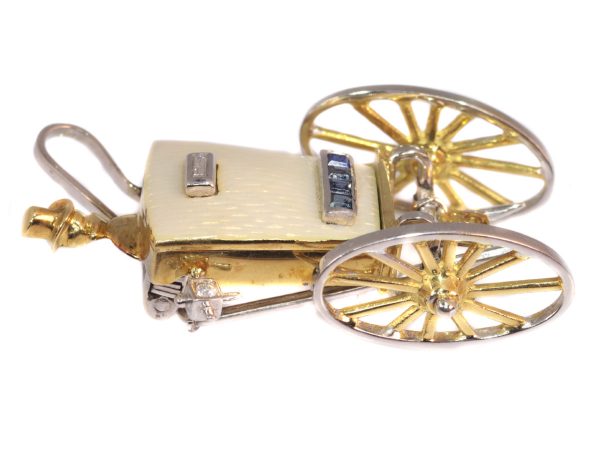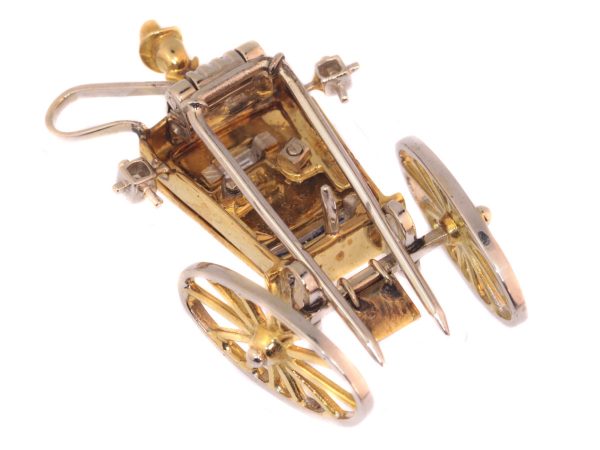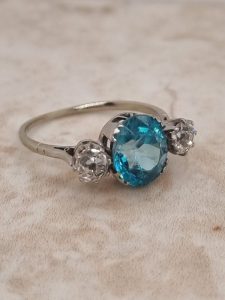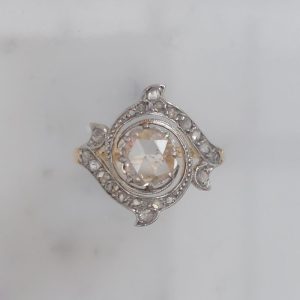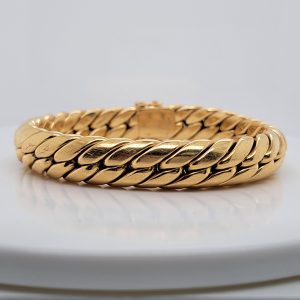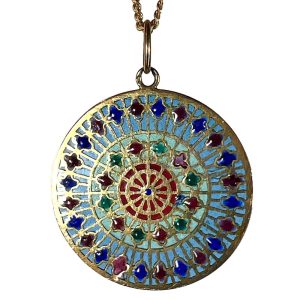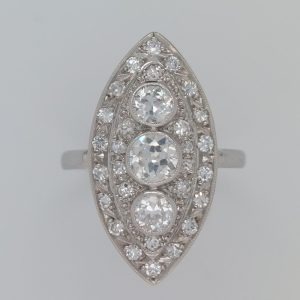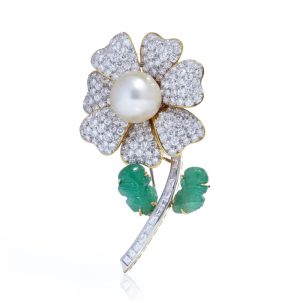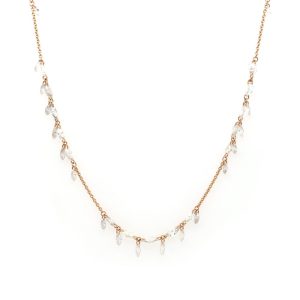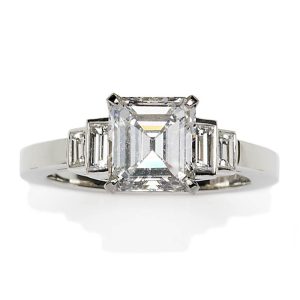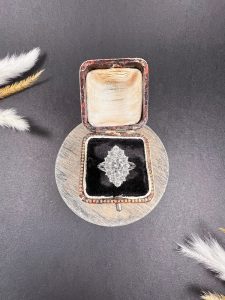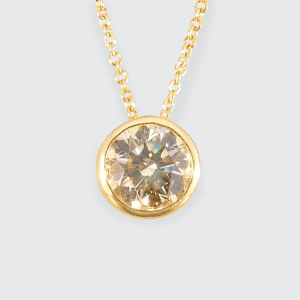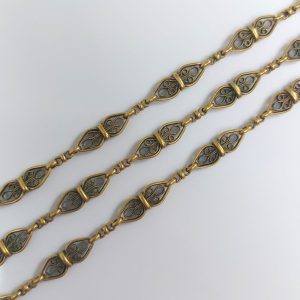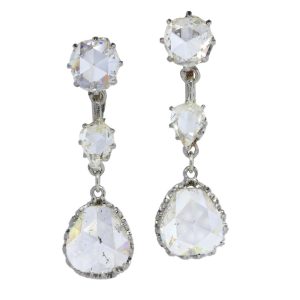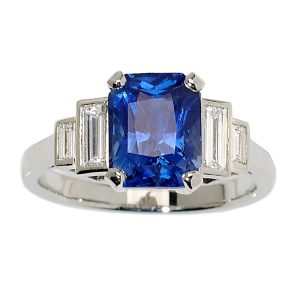Vintage Fifties Mellerio Style Whimsical Gold Carriage Brooch
Looking forward to whatever road lies ahead, this Italian Fifties 18ct gold carriage built in Mellerio style has the ability to carry you to any gala you could ever imagine.
As your fairy godmother, we promise that the coach won’t change into a pumpkin, so even after midnight, you can count on these white gold wheels to take you away in this yellow gold frame with diamonds and sapphires embedded inwhimsical opaline enamel as the white gold lanterns light your path. However, the driver’s got a mind of his own, being a former horse as you know.
Antique jewellery object group: brooch
Condition: very good condition
Country of origin: Italy
Style: Vintage Fifties (of the twentieth century)
Style specifics: This type of jewellery is very specific for the fifties of the twentieth century. All sorts of animals were used as a source of inspiration for the goldsmiths. Made in gold and decorated with enamel and precious stones, the result of their labour most of the times well-made, clever and cute.
Period: ca. 1950
Source of inspiration: Although this jewel is NOT signed Mellerio it has all characteristics of atypical Mellerio jewel. Even more, this model is typically a Mellerio model.
Theme: carriage
Material: 18ct bi-color (yellow and white) gold
Technique: Enamelling is an old and widely-adopted technology. The ancient Egyptians applied enamels to pottery and stone objects. The ancient Greeks, Celts, Russians, and Chinese also used enamelling processes on metal objects. Enamel is the colourful result of fusing powdered glass to a substrate by firing, usually between 750 and 850 degrees Celsius. The powder melts and flows and hardens to a smooth, durable vitreous coating on metal, glass or ceramic. According to some sources, the word enamel comes fromthe High German word smelzan (to smelt) via the Old French esmail. Used as a noun, “an enamel” is a usually small decorative object, coated with enamel coatings, such as a champlevé or a cloisonné (different techniques).
Extra information: Mellerio – François Mellerio (1772-1843) created the foundations of the current house, MELLERIO dits MELLER. Set up at 4, rue du Coq-Saint-Honoré (today rue Marengo), his establisment rapidly grew under the Empire, thanks to Empress Josephine who bought small items from him and attracted in her wake the Emperor’s family, the new nobility and the old aristocracy standing together. In 1815 at the end of the Empire, he transferred the house to 22, rue de la Paix and in the following year went intopartnership with his brother Jean-Jacques. Highly prized by the Orleans family, his most important customer, Mellerio was elevated, after the accession of the Duc d’Orléans to the throne in 1830, to the rank of official supplier to Queen Marie-Amélie, King Louis-Philippe and the royal family.
During the period of the economic crisis caused by the 1848 Revolution, the two brothers thought up the project of setting up an establissement in Spain, which was accomplished in 1850 with the opening of a shop in Madrid “Mellerio-Hermanos” whichrapidly received large orders from Queen Isabelle II and the grandees of Spain. The Second Empire was one of the finest periods for the Mellerio house in Paris. Worthy heirs of their forebears François (born in 1943) and Olivier (born in 1945) thecurrent managers are carrying on this high level of know-how, which warrants that the House is a member of the Comité Colbert and the High Jewelers of France.
Diamond(s): Two brilliant-cut diamonds with an estimated weight of ± 0.02ct.
One baguette (long rectangular) cut diamond with an estimated weight of ± 0.03ct.
Total diamond count: Three pcs.
Total diamond weight: approx. 0.05 ct. with an average colour and clarity: F/H, vs/si.
– All diamond weights, color grades and clarity are approximate since stones are not removed from their mounts topreserve the integrity of the setting. Also, we have all diamonds screened by the IJGC – lab (www.ijgc-worldwide.com) for whether they are natural or synthetic, and all diamonds in this jewel are 100% guaranteed to be natural!
Precious stones: Four sapphires. We did not check if the sapphires are lab produced or not as this information has no influence on the value of this jewel. Natural sapphires and lab produced sapphires were both used in this era, rather more for their effect than for their intrinsic value. with an estimated weight of ± 0.12ct.
– All color stone weights are approximate since stones are not removed from their mounts to preserve the integrity of the setting.
Birthstones: Diamond is the birthstone (or month stone) for April and sapphire for September.
Hallmarks: “750” indicating 18ct gold and “160AL” as master mark for Lunati in Allesandria, Italy
Dimensions: height 4,10 cm (1,61 inch)
Weight: 14,60 gram (9,39 dwt)
Product SKU
JDAD-19220-0011
£4,700
1 in stock
Vintage Fifties Mellerio Style Whimsical Gold Carriage Brooch
Price: £4,700 | Product SKU: JDAD-19220-0011
Please use the form below to enquire about this item. Alternatively you can call us directly on 020 7438 2046 or email us at [email protected].

